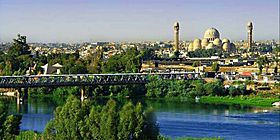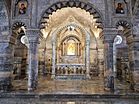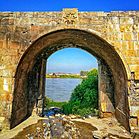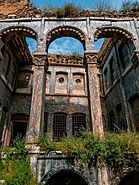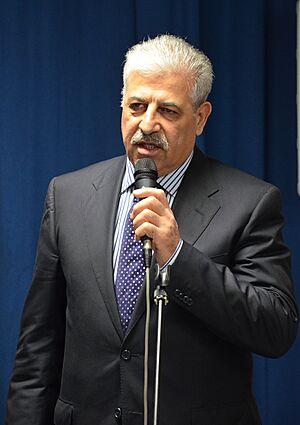Nineveh Governorate facts for kids
Quick facts for kids
Nineveh Governorate
محافظة نينوى (in Arabic)
|
|||
|---|---|---|---|
|
Top-bottom, R-L:
View over Tigris river Church of Saint Thomas • Hatra Mosul Rural area • The river's gate Mosul Museum • Heritage house |
|||
|
|||
 |
|||
| Country | |||
| Capital | Mosul | ||
| Area | |||
| • Total | 37,323 km2 (14,410 sq mi) | ||
| Population
(Estimate 2018)
|
|||
| • Total | 3,730,000 | ||
| • Density | 99.94/km2 (258.8/sq mi) | ||
| HDI (2017) | 0.664 medium |
||
Nineveh Governorate, also called Ninawa Governorate, is a region in northern Iraq. It covers about 37,323 square kilometers. As of 2018, about 3,730,000 people live in Nineveh.
Its biggest city and capital is Mosul. Mosul is located across the Tigris River from the ancient city of Nineveh. Before 1976, it was known as Mosul Province. At that time, it also included the area of today's Dohuk Governorate. The second largest city in Nineveh is Tal Afar. Most people living in Tal Afar are Turkmen.
Nineveh is a very diverse region. Many different groups of people live there. In 2014, a group called ISIS took over parts of the area. Iraqi government forces later took back the city of Mosul in 2017.
Contents
History of Nineveh Governorate
The cities of Mosul and Tal Afar were not damaged during the 2003 U.S.-led invasion of Iraq. However, in 2004, these cities saw strong fighting. This was between US-led troops and local groups. These groups moved to Nineveh after a battle in Fallujah in 2004.
After the invasion, American military leaders helped manage the province. They worked with local Iraqi officials.
In June 2004, Osama Kashmoula became the temporary governor. He was later killed while traveling. Duraid Kashmoula then became the temporary governor. He was elected governor in January 2005. Duraid Kashmoula stepped down in 2009.
In April 2009, Atheel al-Nujaifi became the new governor. He was a strong Arab nationalist. In June 2014, ISIS took over the capital city of Mosul. This caused many people to leave the area. Governor al-Nujaifi also had to leave. The Iraqi Parliament then removed him from his position.
Later, the provincial council elected Nofal Hammadi al-Sultan as governor. In October 2016, an effort to take back Mosul from ISIS began. Iraqi and Kurdish soldiers, supported by a U.S.-led group of nations, worked together.
Geography of Nineveh
Borders of the Province
Nineveh Province shares its borders with several other Iraqi governorates. These include Dohuk, Kirkuk, Erbil, Saladin, and Anbar. It also has a border with the country of Syria. This border is mostly with Syria's Al-Hasakah Governorate and Deir ez-Zor Governorate.
Districts of Nineveh
Nineveh Governorate is divided into 9 smaller areas called districts. Here is a list of these districts. It includes their estimated populations and areas from 2018.
| No. | District | Name in Arabic |
Population in 2018 |
Area in sq. km |
|---|---|---|---|---|
| 1. | Mosul | الموصل | 1,905,174 | 4,318 |
| 2. | Tel Afar | تلعفر | 511,004 | 4,286 |
| 3. | Sinjar | سنجار | 325,816 | 3,576 |
| 4. | Al-Hamdaniya | الحمدانية | 210,601 | 740.6 |
| 5. | Tel Keppe | تلكيف | 210,263 | 1,218 |
| 6. | Makhmūr | مخمور | 209,545 | 2,682 |
| 7. | Al-Ba'aj | البعاج | 179,520 | 8,359 |
| 8. | Al-Hadar (Hatra) | الحضر | 59,429 | 11,130 |
| 9. | Shekhan | شيخان | 43,984 | 466 |
| Total | 3,729,998 | 36,700 |
People of Nineveh
| Historical population | ||
|---|---|---|
| Year | Pop. | ±% p.a. |
| 1977 | 1,105,700 | — |
| 1987 | 1,479,430 | +2.95% |
| 1997 | 2,042,852 | +3.28% |
| 2009 | 3,106,948 | +3.56% |
| 2018 | 3,729,998 | +2.05% |
| Source: Citypopulation | ||
Nineveh Province is home to many different ethnic groups. These include Arabs, Assyrians, Turkmens, Kurds, and Yazidis. They live in both towns and cities, as well as in their own special villages and regions. There are also smaller groups like Armenians, Kawliya, Mandeans, and Shabaks.
Most people in Nineveh are Sunni Muslim. This includes about 80% of the Arabs, as well as many Turkmens and Kurds. About 5–10% of the population are Christian. Groups like Yazidis, Shabaks, and Mandeans follow their own traditional religions.
The main language spoken in Nineveh is Arabic. Other languages spoken by smaller groups include Turkmen, different Neo-Aramaic dialects, Kurdish (mostly a type called Kurmanji), and Armenian.
Idea for an Assyrian Region
Many Assyrian leaders have suggested creating an independent Assyrian homeland. This would be a special area within Nineveh Province, mainly in the Nineveh Plains region. It would be for the Assyrian people.
See also
 In Spanish: Gobernación de Nínive para niños
In Spanish: Gobernación de Nínive para niños
- Nineveh Plains
- Assyrian homeland
- List of Yazidi settlements
- List of churches and monasteries in Nineveh
- Proposals for Assyrian autonomy in Iraq


